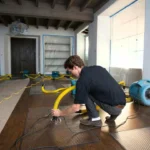Replacing a roof is a significant home improvement project that protects your house from the elements while enhancing its value and appearance. Understanding the roof replacement process can help you prepare for this substantial undertaking. Each phase involves precise coordination between contractors and homeowners, from the initial inspection to the final clean-up. We will explore the key steps of the roof replacement process, providing insights into what you can anticipate. By understanding these stages, you can ensure a smoother experience and minimize surprises.
Inspection and Consultation: Setting the Foundation
The roof replacement process begins with a comprehensive inspection and consultation. A roofing contractor will assess the condition of your roof to identify underlying issues, such as leaks, structural damage, or aging materials. During this phase, measurements are taken to estimate the required materials, and the contractor discusses your preferences for roofing materials, colors, and styles. This stage allows you to ask questions, clarify concerns, and receive a detailed project estimate.
The contractor’s inspection also includes evaluating your home’s attic ventilation, insulation, and overall structure to ensure they support the new roof. This step is vital for addressing potential issues that might affect the longevity of your replacement. Additionally, this is when you’ll discuss timelines, budget considerations, and warranty options. This phase lays the groundwork for the rest of the project, ensuring everyone is aligned on expectations and goals before construction begins.
Selecting Materials and Obtaining Permits
Once the inspection and consultation are complete, the next step is selecting materials and securing the necessary permits. Roofing contractors will present options that suit your budget, climate, and aesthetic preferences. Popular choices include asphalt shingles, metal roofing, clay tiles, and more. Each material comes with its durability, cost, and maintenance considerations.
Meanwhile, your contractor will obtain any permits required by local building codes. Permit requirements vary depending on location but are essential for ensuring the work complies with regulations. Depending on your jurisdiction, the approval process may take a few days to weeks. While waiting for permits, the contractor typically coordinates with suppliers to order materials and schedule delivery. This stage is crucial as it addresses all logistical details before the physical work begins.
Preparing Your Home for Roof Replacement
Preparation is critical to the roof replacement process to ensure safety and minimize disruptions. Before the work starts, contractors may advise you to clear your attic, remove fragile items from walls, and protect furniture and valuables. You should also move vehicles and outdoor furniture away from the work zone to create space for equipment and prevent accidental damage.
Contractors will install safety measures such as tarps and plywood to protect your property, landscaping, and windows from debris. This stage may also involve setting up dumpsters or designated areas for waste disposal. Communication is key during this phase, as the contractor will inform you about the work schedule and any temporary disruptions to utilities or access to your home. Proper preparation ensures the project proceeds efficiently while minimizing inconvenience to you and your family.
Removal of the Old Roof
The first physical step in roof replacement is removing the existing roof. To expose the roof deck, contractors strip away old shingles, underlayment, and other materials. This labor-intensive phase generates debris, which contractors manage using tarps, bins, and proper disposal methods.
During removal, contractors may uncover hidden issues such as rotting wood, mold, or structural weaknesses. Addressing these problems is crucial before installing the new roof to ensure stability and durability. This stage requires skilled labor and attention to detail, as any overlooked issues can compromise the quality of the replacement. Removing the old roof provides a clean slate for the new materials, setting the stage for a long-lasting installation.
Inspecting and Repairing the Roof Deck
After removing the old roof, contractors thoroughly inspect the roof deck for damage. The deck is the foundation for the new roof, so it must be in excellent condition. Any rotted or weakened wood is replaced to ensure the structure can support the new materials.
In some cases, contractors may also assess and upgrade ventilation systems to improve energy efficiency and prevent moisture buildup. Proper ventilation is essential for maintaining the integrity of your roof and extending its lifespan. This inspection and repair phase is crucial in ensuring your new roof performs optimally, addressing any issues before installation begins.
Installing the New Roof
With the roof deck prepared, the new roof installation begins. Contractors start by laying down an underlayment, a moisture barrier, to protect your home. Depending on the roofing material, additional layers, such as ice and water shields, may be added in vulnerable areas.
Shingles, tiles, or panels are then installed in a precise pattern to ensure uniformity and durability. Contractors pay close attention to flashing, gutters, and edges, as these areas are prone to leaks if not sealed properly. This phase requires precision and teamwork, as contractors must follow manufacturer guidelines and building codes to deliver a quality installation. Weather conditions also play a role; contractors schedule installation during favorable conditions to avoid delays or complications.
A roof replacement is a multifaceted process that involves careful planning, skilled labor, and open communication between contractors and homeowners. By understanding each stage—from inspection and material selection to installation and clean-up—you can prepare for the project and reduce potential stress. We have explored the essential steps to help you anticipate what to expect during the roof replacement. With a clear understanding of the timeline and responsibilities, you can ensure a smooth experience and enjoy the benefits of a durable, long-lasting roof for years to come.

Shannon Reyes is a seasoned writer with a knack for crafting engaging blogs on a variety of service industries, including plumbing, cleansing, moving, pest control, and roofing. With a keen eye for detail and a passion for helping readers navigate complex topics, Shannon brings her expertise to life through informative and accessible content.










